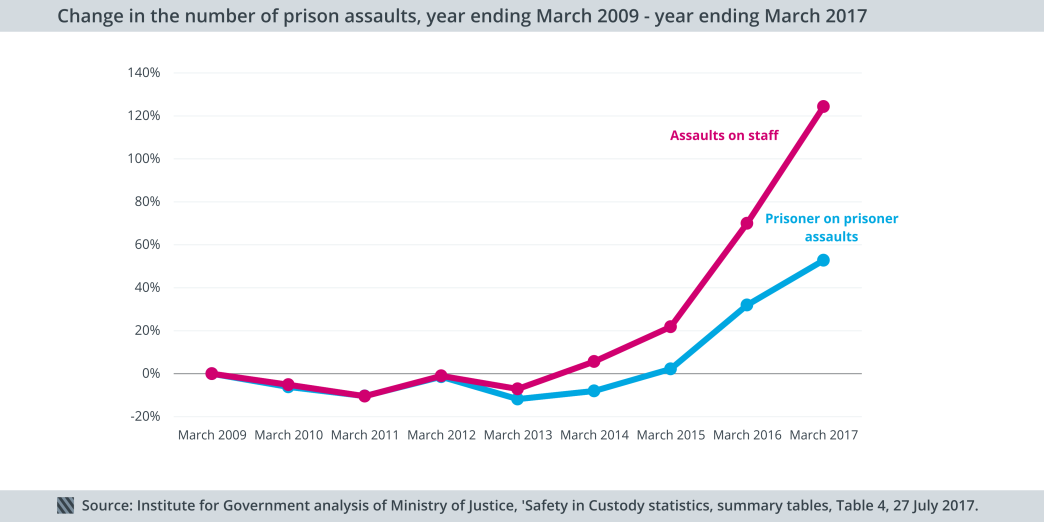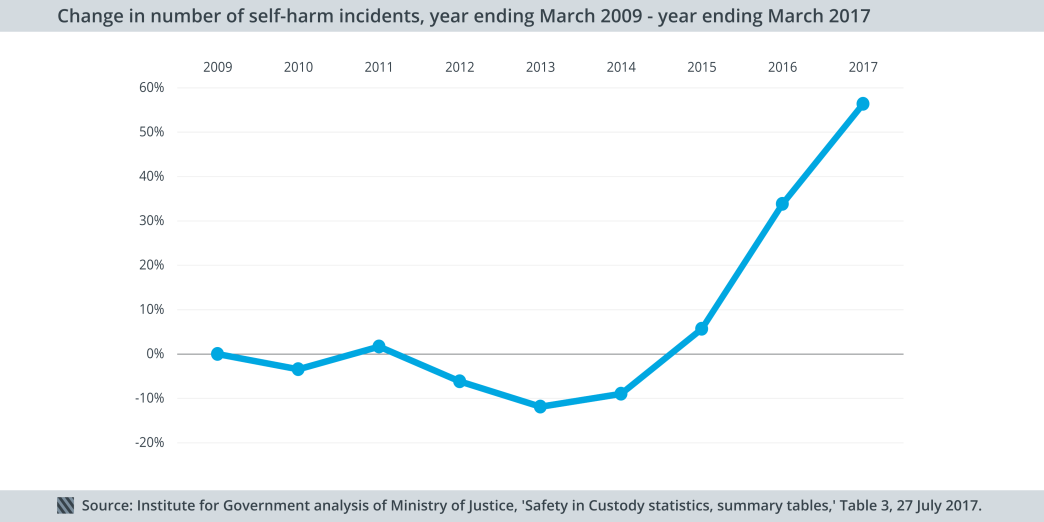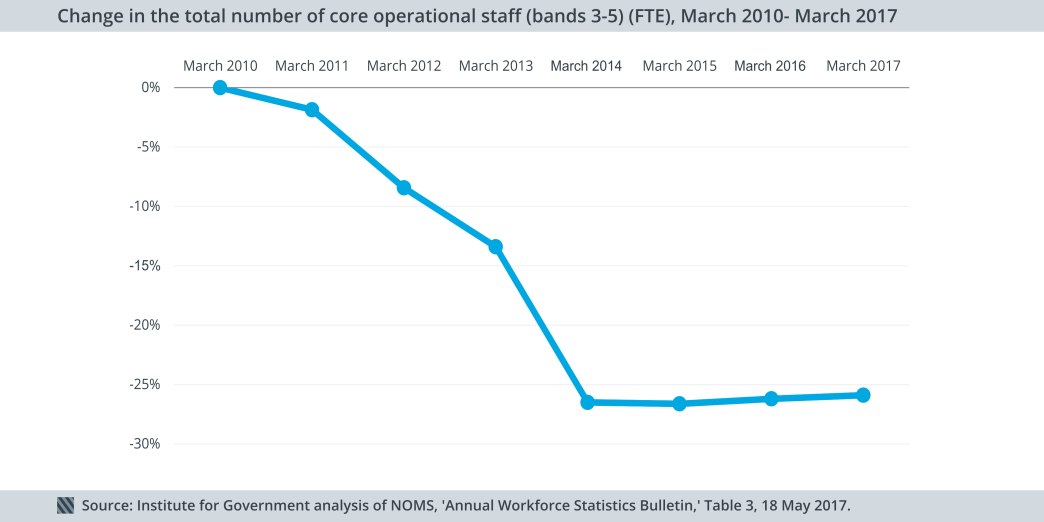Once services are allowed to reach the point of crisis - as prisons have - it is very difficult to turn them around. The Government must base its spending decisions on what the data tells them, argues Alice Lilly.
Figures released yesterday by the Ministry of Justice (MoJ) paint a picture of worsening violence in prisons across England and Wales, echoing the recent finding of Her Majesty’s Inspector of Prisons.
The Institute for Government (IFG) has argued that ignoring early warning signs in prisons data when making spending decisions runs the risk of pushing services into a cycle of ‘crisis, cash, repeat’. Once you’re in that cycle it is difficult to get out.
The Justice Secretary recently wrote that “we know where the problems lie in our prisons, and we know what is needed to fix them”. But to get a grip on the increasing rates of violence in prisons, the Government needs to closely monitor its own data to base future spending decisions on what the numbers tell them.
Assaults in prisons have risen since 2009 – particularly after 2015

Yesterday’s data shows that in the year to March, there were 26,643 assaults in prisons - a record high.
There were 7,159 assaults on staff in the 12 months to March - a 124% increase on the 3,191 in the year to March 2009.
Assaults on staff have risen every year since 2013, but they became markedly steeper after 2015: in the last two years alone, they have risen by 84%.
The number of serious assaults on staff has also risen - from 282 in the year to March 2009, to 805 in the year to March 2017. Much of this increase has also come since 2013 and rates of serious assaults on staff have almost trebled since then.
Prisoner-on-prisoner assaults also continue to rise. There were 19,361 incidents in the year to March 2017, a 53% increase on the year to March 2009. These follow the same pattern as assaults on staff which began to rise from 2013 and then rapidly increasing after 2015.
Rates of self-harm have risen since 2009
Yesterday’s numbers also show a continuing rise in the number of self-harm incidents recorded across all prisons.

In the year to March 2017, there were 40,414 self-harm incidents - 56% more than the 25,847 recorded in the 12 months to March 2009.
In the last year alone, there has been a 17% rise.
While rates of self-harm have stabilised over the last five quarters, they have done so at record highs. The proportion of incidents requiring hospital attendance has also risen over this period from 5.1% in 2009 to 6.9% in 2017 (a slight decrease from the 7.1% of incidents in 2016).
Rising rates of self-harm and assaults led the Prison Reform Trust to conclude that those within prisons are “less safe than they have been at any point since records began”.
The Government must focus on staff retention, as well as recruitment
The number of prisons officers fell by over 25% between 2009 and 2014 but they have since stabilised. Signs that all was not well in prisons were clearly visible in the data by March 2015, when assaults on staff rose 15% in a year.

That autumn, the Ministry of Justice (MoJ) was tasked with making a 15% reduction in spending in the 2015 Spending Review. Just a year later as violence continued to intensify the Government was forced into emergency action, committing to recruit additional prison officers and effectively reversing almost half of the staff cuts made since 2010.
There are clear signs that this process is underway. In March 2017, there were 18,403 core Band 3-5 officers in post, up 2.9% (515 staff) on the previous quarter. The new Justice Secretary, David Lidington, wrote last month that the department is on track to have 2,500 new officers in place by December 2018.
However, the data also makes clear that there are problems with retaining current staff. In the year to March 2017, the leaving rate for core Band 3-5 prison officers was 9.4%, an increase of 1.9% on the previous year. The Government has recognised this and earlier this year announced pay rises for staff at 31 jails in London and South East England, where retention and recruitment pressures have been acute.
But it will need to continue to monitor the data to ensure that it is effectively targeting its resources.
Alongside efforts to recruit new staff and increase pay, the Government announced a host of other measures in a white paper published last year. Many of these measures were contained within the Prisons and Courts Bill, which was dropped due to the election.
In the Queen’s Speech last month, a new bill was announced focusing on courts reform, rather than prisons, drawing criticism from the Chief Inspector of Prisons. It has been suggested that some of the proposed measures in the old Prisons and Courts Bill may not require primary legislation, and the Chief Inspector of Prisons has called for them to be achieved by other means, such as administrative directions.
The new Justice Secretary David Lidington has affirmed his commitment to reform. But the Government’s efforts to improve the situation in prisons must follow the data.
The next edition of Performance Tracker – a data-driven analysis of the performance of Government from the Institute for Government and the Chartered Institute of Public Finance and Accountancy - will be published this autumn.
Read the Prisons chapter from the Spring 2017 Performance Tracker report.
- Supporting document
- Performance Tracker final web.pdf (PDF, 976.99 KB)
- Topic
- Public services